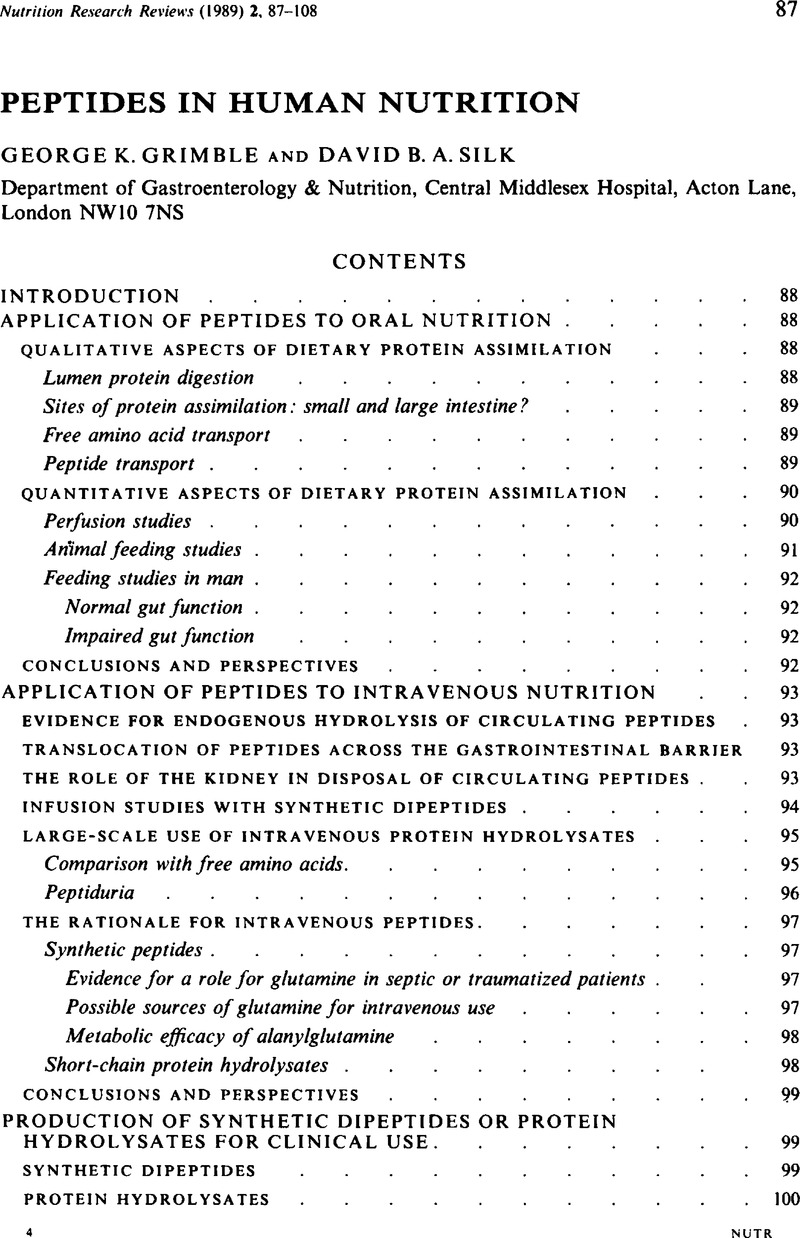Crossref Citations
This article has been cited by the following publications. This list is generated based on data provided by Crossref.
Grimble, George K.
and
Silk, David B.A.
1990.
Invited Review: The Nitrogen Source of Elemental Diets—an Unresolved Issue?.
Nutrition in Clinical Practice,
Vol. 5,
Issue. 6,
p.
227.
Grimble, G.K.
and
Silk, D.B.A.
1990.
Intravenous protein hydrolysates—Time to turn the clock back?.
Clinical Nutrition,
Vol. 9,
Issue. 1,
p.
39.
Miyamoto, Y
Thompson, Y G
Howard, E F
Ganapathy, V
and
Leibach, F H
1991.
Functional expression of the intestinal peptide-proton co-transporter in Xenopus laevis oocytes..
Journal of Biological Chemistry,
Vol. 266,
Issue. 8,
p.
4742.
Boisen, S.
and
Eggum, B. O.
1991.
Critical Evaluation of in Vitro Methods for Estimating Digestibility in Simple-Stomach Animals.
Nutrition Research Reviews,
Vol. 4,
Issue. 1,
p.
141.
Tarvid, I.
1991.
Early postnatal development of peptide hydrolysis in chicks and guinea pigs.
Comparative Biochemistry and Physiology Part A: Physiology,
Vol. 99,
Issue. 3,
p.
441.
Grimble, George K.
Payne-James, J. Jason
and
Silk, David B.A.
1992.
Advances in nutrition in the critically ill.
Baillière's Clinical Anaesthesiology,
Vol. 6,
Issue. 2,
p.
213.
1992.
Abstracts of Communications.
Proceedings of the Nutrition Society,
Vol. 51,
Issue. 2,
p.
93A.
Grimble, G.
1993.
Glutamine, glutamate and pyroglutamate — facts and fantasies.
Clinical Nutrition,
Vol. 12,
Issue. 1,
p.
66.
Rérat, Alain A.
1993.
Nutritional supply of proteins and absorption of their hydrolysis products: consequences on metabolism.
Proceedings of the Nutrition Society,
Vol. 52,
Issue. 2,
p.
335.
Chan, Yin-Ching
Yokota, Ayako
Maeuchihara, Kaoru
Maekawa, Tadashi
Asato, Liu
and
Yamamoto, Shigeru
1993.
Comparative effect of amino acid mixtures with or without asparagine and glutamine on growth of rats.
Nutrition Research,
Vol. 13,
Issue. 8,
p.
923.
Webb, K.E.
Dirienzo, D.B.
and
Matthews, J.C.
1993.
Recent Developments in Gastrointestinal Absorption and Tissue Utilization of Peptides: A Review.
Journal of Dairy Science,
Vol. 76,
Issue. 1,
p.
351.
Krediet, Raymond T.
Imholz, Alexander L.T.
Lameire, Norbert
Faict, Dirk
Koomen, Gerardus C.M.
and
Martis, Leo
1994.
The Use of Peptides in Peritoneal Dialysis Fluids.
Peritoneal Dialysis International: Journal of the International Society for Peritoneal Dialysis,
Vol. 14,
Issue. 3_suppl,
p.
152.
Colette Backwell, F. R.
1994.
Peptide utilization by tissues: current status and applications of stable isotope procedures.
Proceedings of the Nutrition Society,
Vol. 53,
Issue. 3,
p.
457.
Rérat, A.
1995.
Nutritional value of protein hydrolysis products (Oligopeptides and free amino acids) as a consequence of absorption and metabolism kinetics.
Archiv für Tierernaehrung,
Vol. 48,
Issue. 1-2,
p.
23.
Boza, Julio J.
Martínez-Augustin, Olga
Baró, Luis
Suarez, M. Dolores
and
Gil, Angel
1995.
Protein v. enzymic protein hydrolysates. Nitrogen utilization in starved rats.
British Journal of Nutrition,
Vol. 73,
Issue. 1,
p.
65.
Deutz, N.E.P.
Welters, C.F.M.
and
Soeters, P.B.
1996.
Intragastric bolus feeding of meals containing elementary, partially hydrolyzed or intact protein causes comparable changes in interorgan substrate flux in the pig.
Clinical Nutrition,
Vol. 15,
Issue. 3,
p.
119.
Mesgaran, M D
and
Parker, D S
1996.
Influence of Dipeptide Structure on Hydrolysis by Rumen Fluid and Blood of Sheep.
Proceedings of the British Society of Animal Science,
Vol. 1996,
Issue. ,
p.
177.
Mesgaran, M D
and
Parker, D S
1996.
Influence of Dipeptide Structure on Hydrolysis by Rumen Fluid and Blood of Sheep.
Proceedings of the British Society of Animal Science,
Vol. 1996,
Issue. ,
p.
177.
Boirie, Y.
Gachon, P.
Corny, S.
Fauquant, J.
Maubois, J. L.
and
Beaufrere, B.
1996.
Acute postprandial changes in leucine metabolism as assessed with an intrinsically labeled milk protein.
American Journal of Physiology-Endocrinology and Metabolism,
Vol. 271,
Issue. 6,
p.
E1083.
Zhao, Qiuyu
Le Coeur, Catherine
and
Piot, Jean Marie
1997.
Analysis of peptides from bovine hemoglobin and tuna myoglobin enzymatic hydrolysate: use of HPLC with on-line second-order derivative spectroscopy for the characterization of biologically active peptides.
Analytica Chimica Acta,
Vol. 352,
Issue. 1-3,
p.
201.



